Stakeholder Relationship Management at Ngāi Tahu Holdings Ltd
VerifiedAdded on 2023/06/11
|17
|4445
|204
Report
AI Summary
This report provides an analysis of stakeholder relationship management within Ngāi Tahu Holdings Corporation Limited, a multifaceted organization in New Zealand. It examines the impact of the internal and external environments on key stakeholders, including employees, board of directors, clients, and investors. The report delves into stakeholder engagement processes, methods for raising awareness, and the significance of these relationships for the company's management practices and overall performance. The analysis incorporates both quantitative and qualitative tools to assess the company's strategic plans and the importance of stakeholder relationships in achieving its missions and visions, ultimately impacting the economic health and sustainability of the organization.
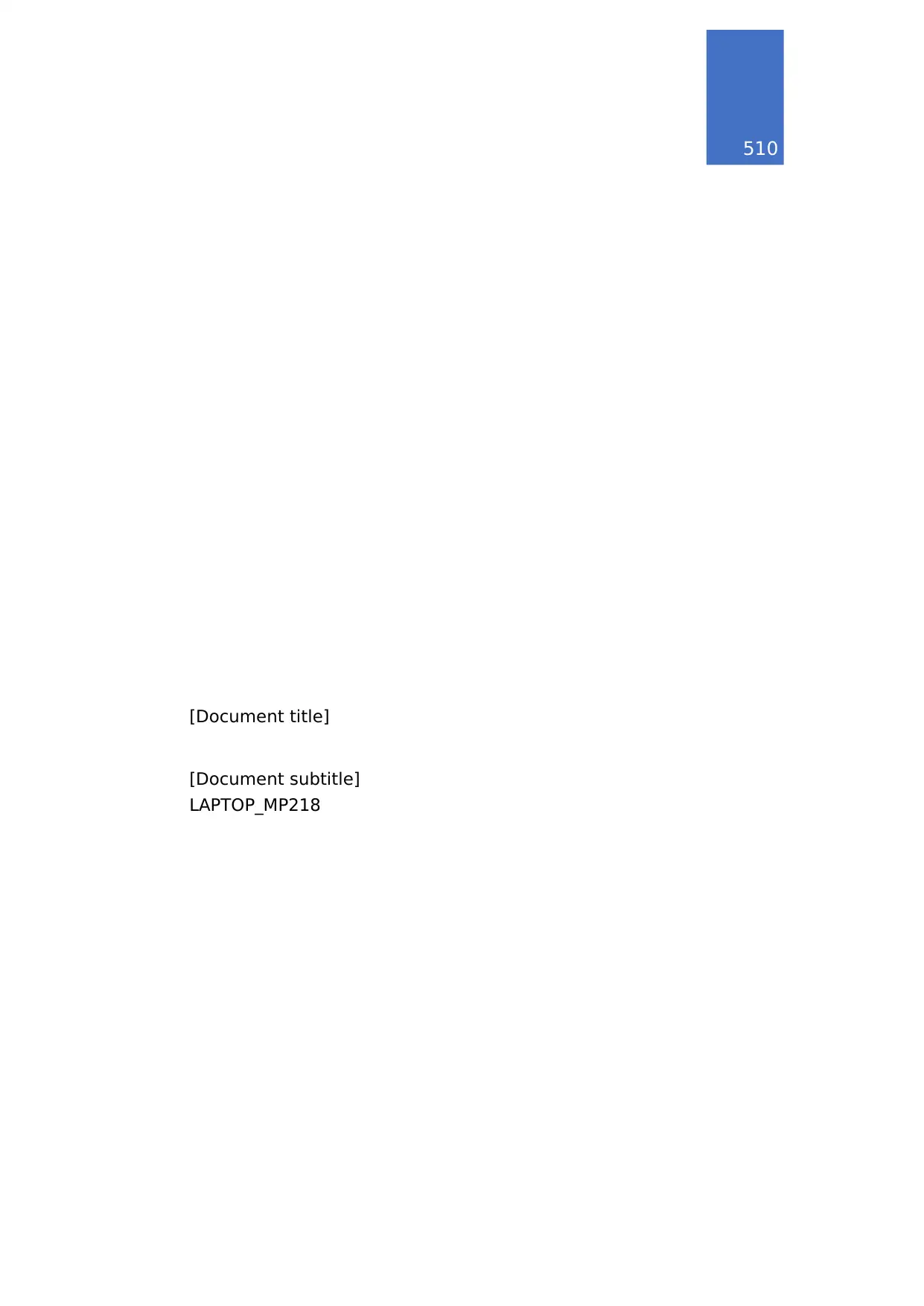
510
[Document title]
[Document subtitle]
LAPTOP_MP218
[Document title]
[Document subtitle]
LAPTOP_MP218
Paraphrase This Document
Need a fresh take? Get an instant paraphrase of this document with our AI Paraphraser
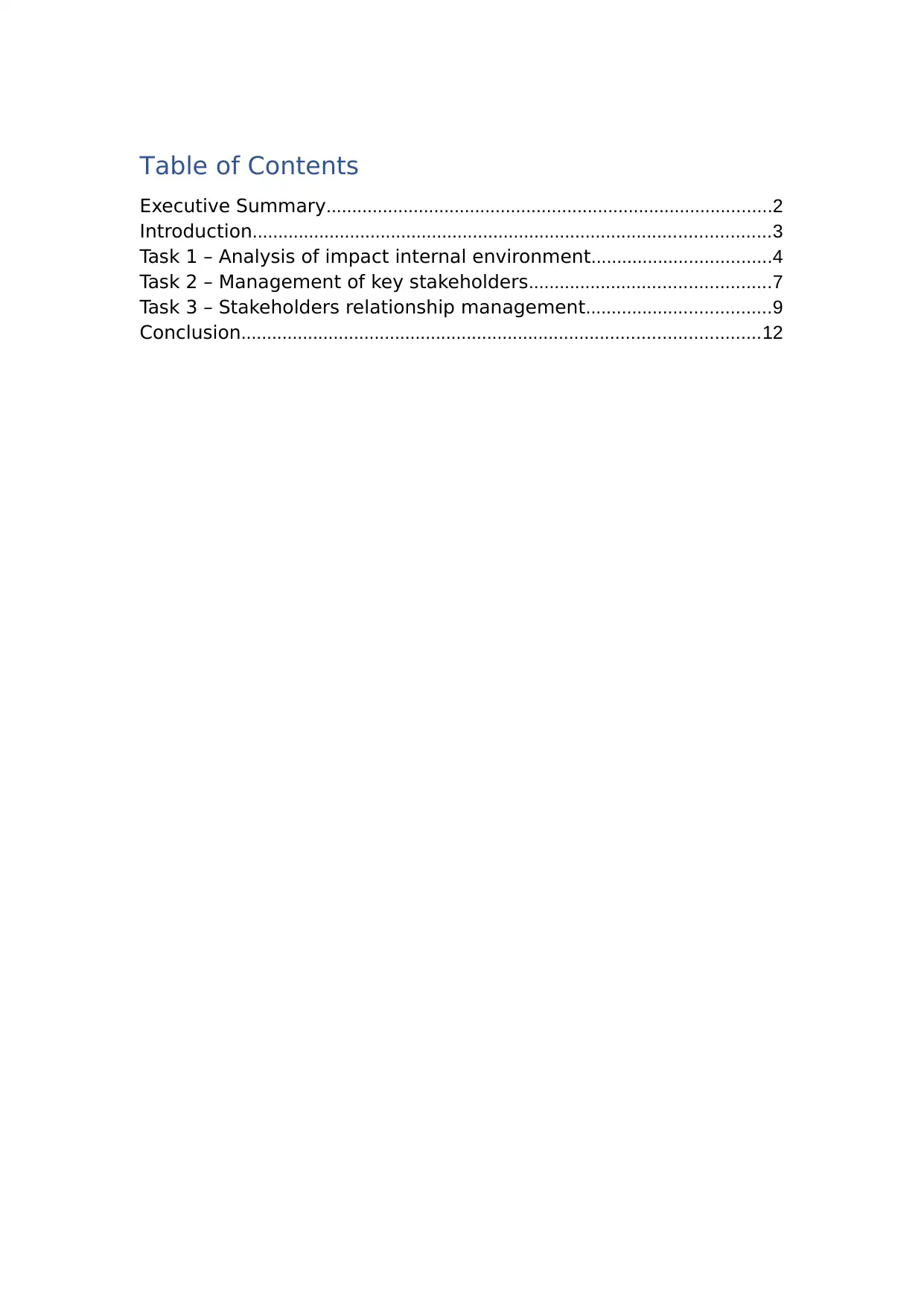
Table of Contents
Executive Summary.......................................................................................2
Introduction.....................................................................................................3
Task 1 – Analysis of impact internal environment...................................4
Task 2 – Management of key stakeholders...............................................7
Task 3 – Stakeholders relationship management....................................9
Conclusion.....................................................................................................12
Executive Summary.......................................................................................2
Introduction.....................................................................................................3
Task 1 – Analysis of impact internal environment...................................4
Task 2 – Management of key stakeholders...............................................7
Task 3 – Stakeholders relationship management....................................9
Conclusion.....................................................................................................12
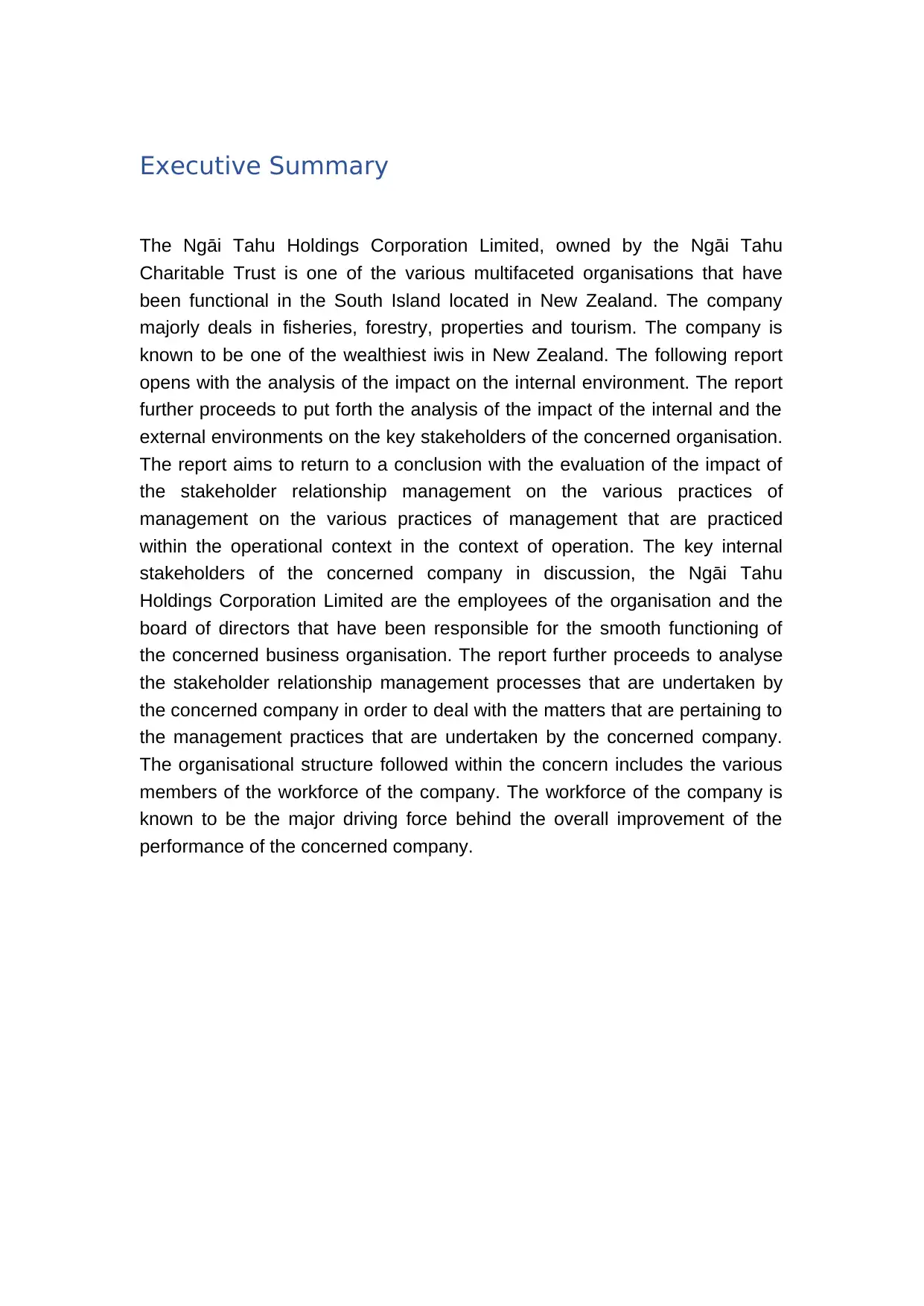
Executive Summary
The Ngāi Tahu Holdings Corporation Limited, owned by the Ngāi Tahu
Charitable Trust is one of the various multifaceted organisations that have
been functional in the South Island located in New Zealand. The company
majorly deals in fisheries, forestry, properties and tourism. The company is
known to be one of the wealthiest iwis in New Zealand. The following report
opens with the analysis of the impact on the internal environment. The report
further proceeds to put forth the analysis of the impact of the internal and the
external environments on the key stakeholders of the concerned organisation.
The report aims to return to a conclusion with the evaluation of the impact of
the stakeholder relationship management on the various practices of
management on the various practices of management that are practiced
within the operational context in the context of operation. The key internal
stakeholders of the concerned company in discussion, the Ngāi Tahu
Holdings Corporation Limited are the employees of the organisation and the
board of directors that have been responsible for the smooth functioning of
the concerned business organisation. The report further proceeds to analyse
the stakeholder relationship management processes that are undertaken by
the concerned company in order to deal with the matters that are pertaining to
the management practices that are undertaken by the concerned company.
The organisational structure followed within the concern includes the various
members of the workforce of the company. The workforce of the company is
known to be the major driving force behind the overall improvement of the
performance of the concerned company.
The Ngāi Tahu Holdings Corporation Limited, owned by the Ngāi Tahu
Charitable Trust is one of the various multifaceted organisations that have
been functional in the South Island located in New Zealand. The company
majorly deals in fisheries, forestry, properties and tourism. The company is
known to be one of the wealthiest iwis in New Zealand. The following report
opens with the analysis of the impact on the internal environment. The report
further proceeds to put forth the analysis of the impact of the internal and the
external environments on the key stakeholders of the concerned organisation.
The report aims to return to a conclusion with the evaluation of the impact of
the stakeholder relationship management on the various practices of
management on the various practices of management that are practiced
within the operational context in the context of operation. The key internal
stakeholders of the concerned company in discussion, the Ngāi Tahu
Holdings Corporation Limited are the employees of the organisation and the
board of directors that have been responsible for the smooth functioning of
the concerned business organisation. The report further proceeds to analyse
the stakeholder relationship management processes that are undertaken by
the concerned company in order to deal with the matters that are pertaining to
the management practices that are undertaken by the concerned company.
The organisational structure followed within the concern includes the various
members of the workforce of the company. The workforce of the company is
known to be the major driving force behind the overall improvement of the
performance of the concerned company.
You're viewing a preview
Unlock full access by subscribing today!
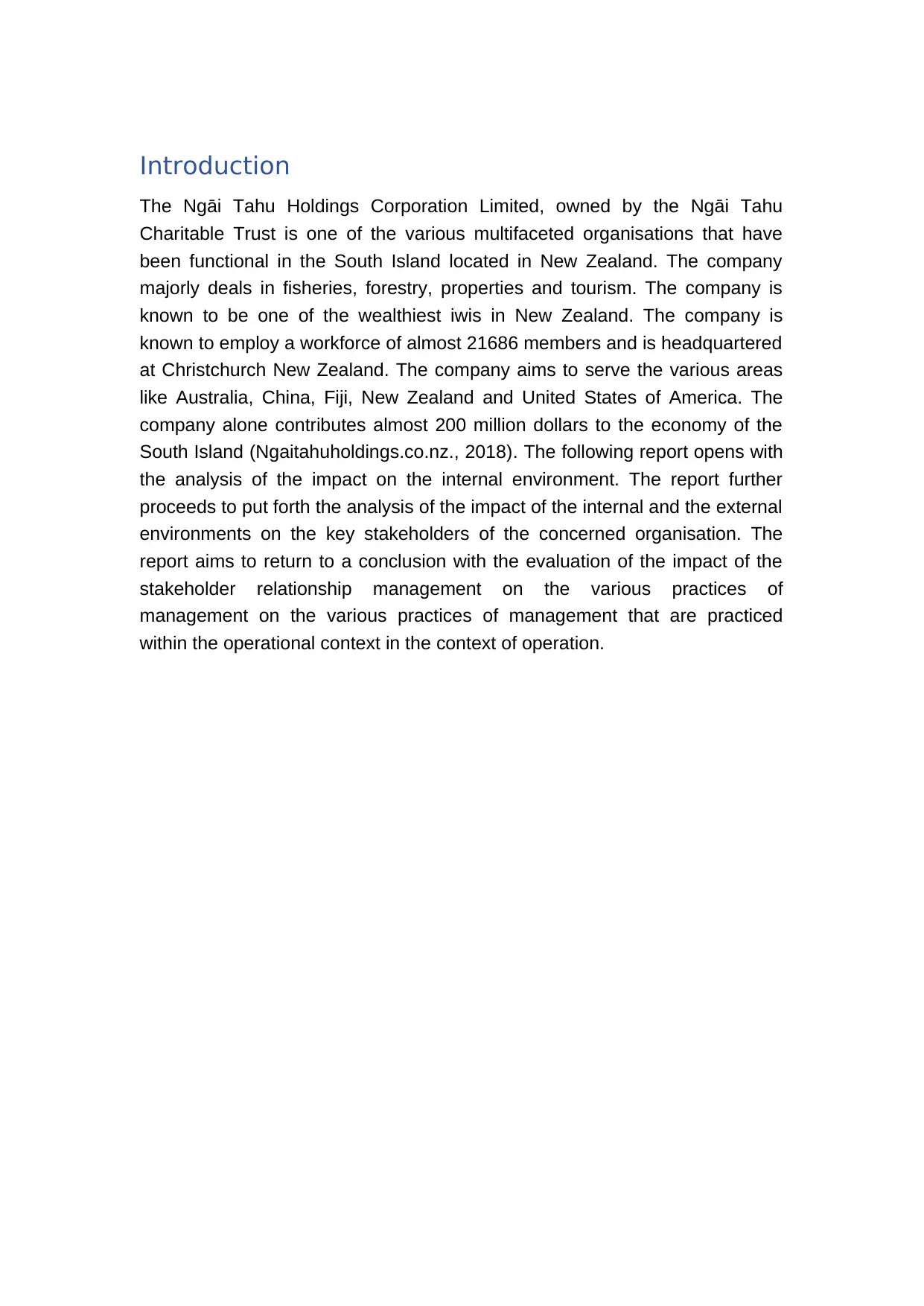
Introduction
The Ngāi Tahu Holdings Corporation Limited, owned by the Ngāi Tahu
Charitable Trust is one of the various multifaceted organisations that have
been functional in the South Island located in New Zealand. The company
majorly deals in fisheries, forestry, properties and tourism. The company is
known to be one of the wealthiest iwis in New Zealand. The company is
known to employ a workforce of almost 21686 members and is headquartered
at Christchurch New Zealand. The company aims to serve the various areas
like Australia, China, Fiji, New Zealand and United States of America. The
company alone contributes almost 200 million dollars to the economy of the
South Island (Ngaitahuholdings.co.nz., 2018). The following report opens with
the analysis of the impact on the internal environment. The report further
proceeds to put forth the analysis of the impact of the internal and the external
environments on the key stakeholders of the concerned organisation. The
report aims to return to a conclusion with the evaluation of the impact of the
stakeholder relationship management on the various practices of
management on the various practices of management that are practiced
within the operational context in the context of operation.
The Ngāi Tahu Holdings Corporation Limited, owned by the Ngāi Tahu
Charitable Trust is one of the various multifaceted organisations that have
been functional in the South Island located in New Zealand. The company
majorly deals in fisheries, forestry, properties and tourism. The company is
known to be one of the wealthiest iwis in New Zealand. The company is
known to employ a workforce of almost 21686 members and is headquartered
at Christchurch New Zealand. The company aims to serve the various areas
like Australia, China, Fiji, New Zealand and United States of America. The
company alone contributes almost 200 million dollars to the economy of the
South Island (Ngaitahuholdings.co.nz., 2018). The following report opens with
the analysis of the impact on the internal environment. The report further
proceeds to put forth the analysis of the impact of the internal and the external
environments on the key stakeholders of the concerned organisation. The
report aims to return to a conclusion with the evaluation of the impact of the
stakeholder relationship management on the various practices of
management on the various practices of management that are practiced
within the operational context in the context of operation.
Paraphrase This Document
Need a fresh take? Get an instant paraphrase of this document with our AI Paraphraser
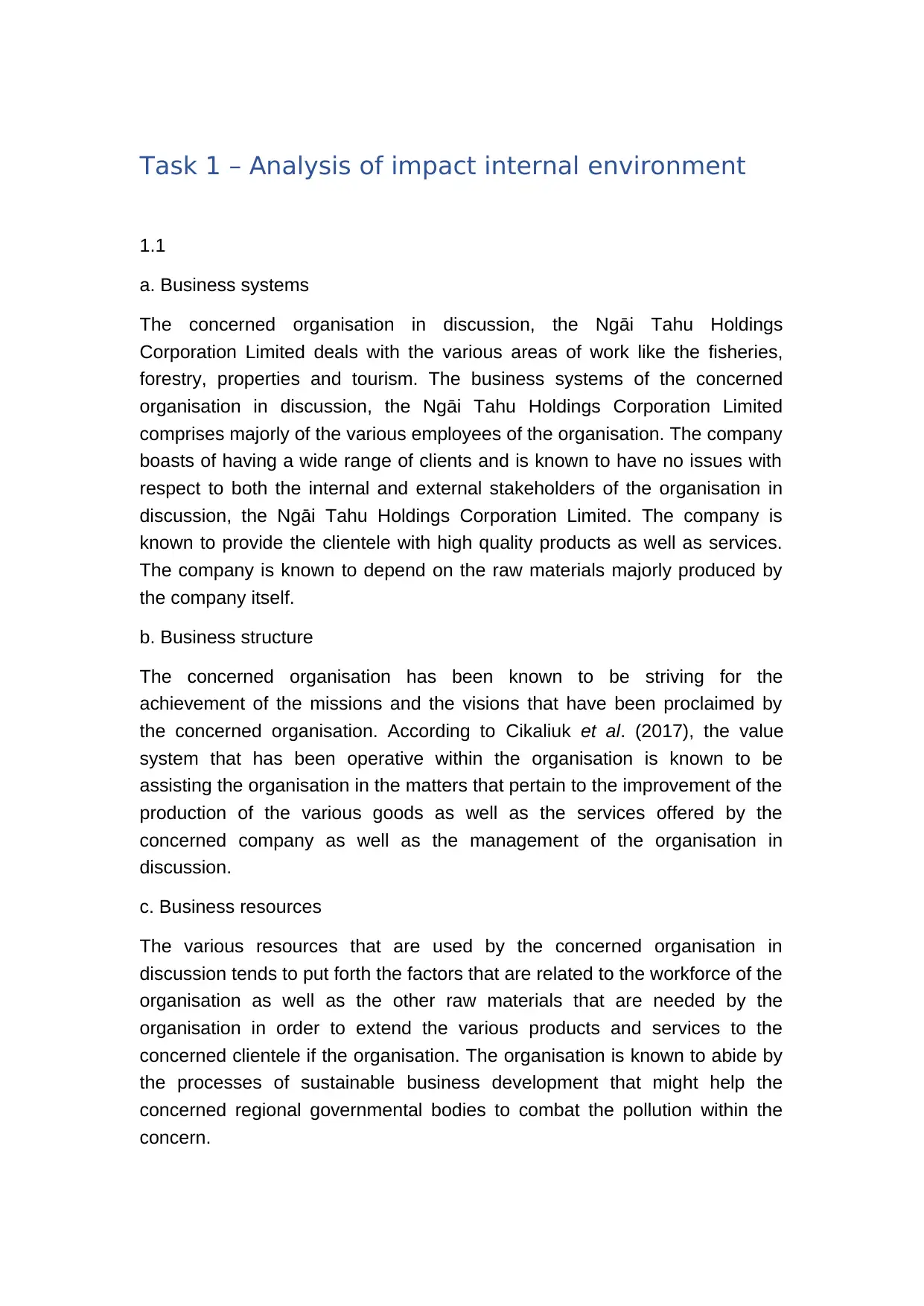
Task 1 – Analysis of impact internal environment
1.1
a. Business systems
The concerned organisation in discussion, the Ngāi Tahu Holdings
Corporation Limited deals with the various areas of work like the fisheries,
forestry, properties and tourism. The business systems of the concerned
organisation in discussion, the Ngāi Tahu Holdings Corporation Limited
comprises majorly of the various employees of the organisation. The company
boasts of having a wide range of clients and is known to have no issues with
respect to both the internal and external stakeholders of the organisation in
discussion, the Ngāi Tahu Holdings Corporation Limited. The company is
known to provide the clientele with high quality products as well as services.
The company is known to depend on the raw materials majorly produced by
the company itself.
b. Business structure
The concerned organisation has been known to be striving for the
achievement of the missions and the visions that have been proclaimed by
the concerned organisation. According to Cikaliuk et al. (2017), the value
system that has been operative within the organisation is known to be
assisting the organisation in the matters that pertain to the improvement of the
production of the various goods as well as the services offered by the
concerned company as well as the management of the organisation in
discussion.
c. Business resources
The various resources that are used by the concerned organisation in
discussion tends to put forth the factors that are related to the workforce of the
organisation as well as the other raw materials that are needed by the
organisation in order to extend the various products and services to the
concerned clientele if the organisation. The organisation is known to abide by
the processes of sustainable business development that might help the
concerned regional governmental bodies to combat the pollution within the
concern.
1.1
a. Business systems
The concerned organisation in discussion, the Ngāi Tahu Holdings
Corporation Limited deals with the various areas of work like the fisheries,
forestry, properties and tourism. The business systems of the concerned
organisation in discussion, the Ngāi Tahu Holdings Corporation Limited
comprises majorly of the various employees of the organisation. The company
boasts of having a wide range of clients and is known to have no issues with
respect to both the internal and external stakeholders of the organisation in
discussion, the Ngāi Tahu Holdings Corporation Limited. The company is
known to provide the clientele with high quality products as well as services.
The company is known to depend on the raw materials majorly produced by
the company itself.
b. Business structure
The concerned organisation has been known to be striving for the
achievement of the missions and the visions that have been proclaimed by
the concerned organisation. According to Cikaliuk et al. (2017), the value
system that has been operative within the organisation is known to be
assisting the organisation in the matters that pertain to the improvement of the
production of the various goods as well as the services offered by the
concerned company as well as the management of the organisation in
discussion.
c. Business resources
The various resources that are used by the concerned organisation in
discussion tends to put forth the factors that are related to the workforce of the
organisation as well as the other raw materials that are needed by the
organisation in order to extend the various products and services to the
concerned clientele if the organisation. The organisation is known to abide by
the processes of sustainable business development that might help the
concerned regional governmental bodies to combat the pollution within the
concern.
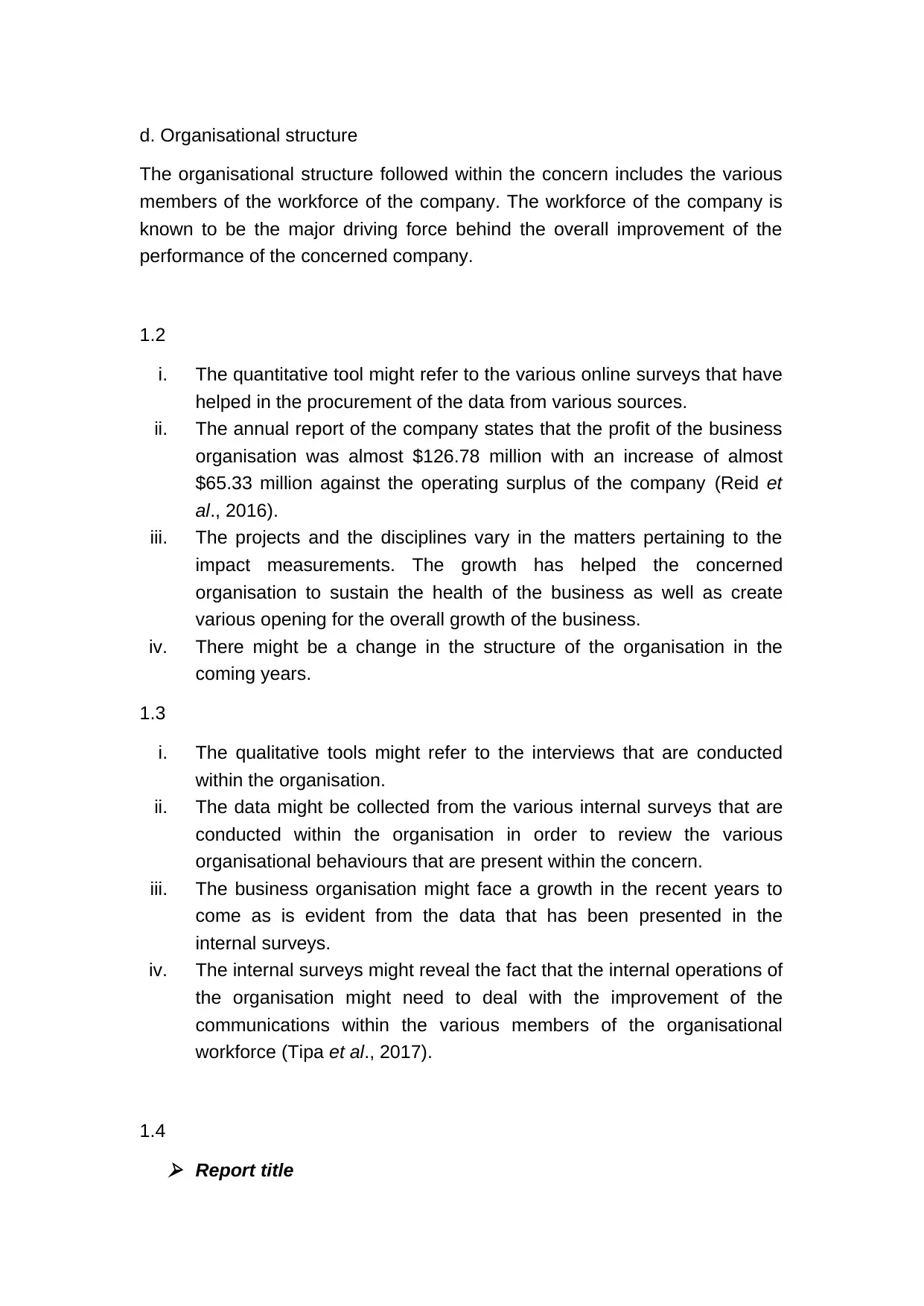
d. Organisational structure
The organisational structure followed within the concern includes the various
members of the workforce of the company. The workforce of the company is
known to be the major driving force behind the overall improvement of the
performance of the concerned company.
1.2
i. The quantitative tool might refer to the various online surveys that have
helped in the procurement of the data from various sources.
ii. The annual report of the company states that the profit of the business
organisation was almost $126.78 million with an increase of almost
$65.33 million against the operating surplus of the company (Reid et
al., 2016).
iii. The projects and the disciplines vary in the matters pertaining to the
impact measurements. The growth has helped the concerned
organisation to sustain the health of the business as well as create
various opening for the overall growth of the business.
iv. There might be a change in the structure of the organisation in the
coming years.
1.3
i. The qualitative tools might refer to the interviews that are conducted
within the organisation.
ii. The data might be collected from the various internal surveys that are
conducted within the organisation in order to review the various
organisational behaviours that are present within the concern.
iii. The business organisation might face a growth in the recent years to
come as is evident from the data that has been presented in the
internal surveys.
iv. The internal surveys might reveal the fact that the internal operations of
the organisation might need to deal with the improvement of the
communications within the various members of the organisational
workforce (Tipa et al., 2017).
1.4 Report title
The organisational structure followed within the concern includes the various
members of the workforce of the company. The workforce of the company is
known to be the major driving force behind the overall improvement of the
performance of the concerned company.
1.2
i. The quantitative tool might refer to the various online surveys that have
helped in the procurement of the data from various sources.
ii. The annual report of the company states that the profit of the business
organisation was almost $126.78 million with an increase of almost
$65.33 million against the operating surplus of the company (Reid et
al., 2016).
iii. The projects and the disciplines vary in the matters pertaining to the
impact measurements. The growth has helped the concerned
organisation to sustain the health of the business as well as create
various opening for the overall growth of the business.
iv. There might be a change in the structure of the organisation in the
coming years.
1.3
i. The qualitative tools might refer to the interviews that are conducted
within the organisation.
ii. The data might be collected from the various internal surveys that are
conducted within the organisation in order to review the various
organisational behaviours that are present within the concern.
iii. The business organisation might face a growth in the recent years to
come as is evident from the data that has been presented in the
internal surveys.
iv. The internal surveys might reveal the fact that the internal operations of
the organisation might need to deal with the improvement of the
communications within the various members of the organisational
workforce (Tipa et al., 2017).
1.4 Report title
You're viewing a preview
Unlock full access by subscribing today!
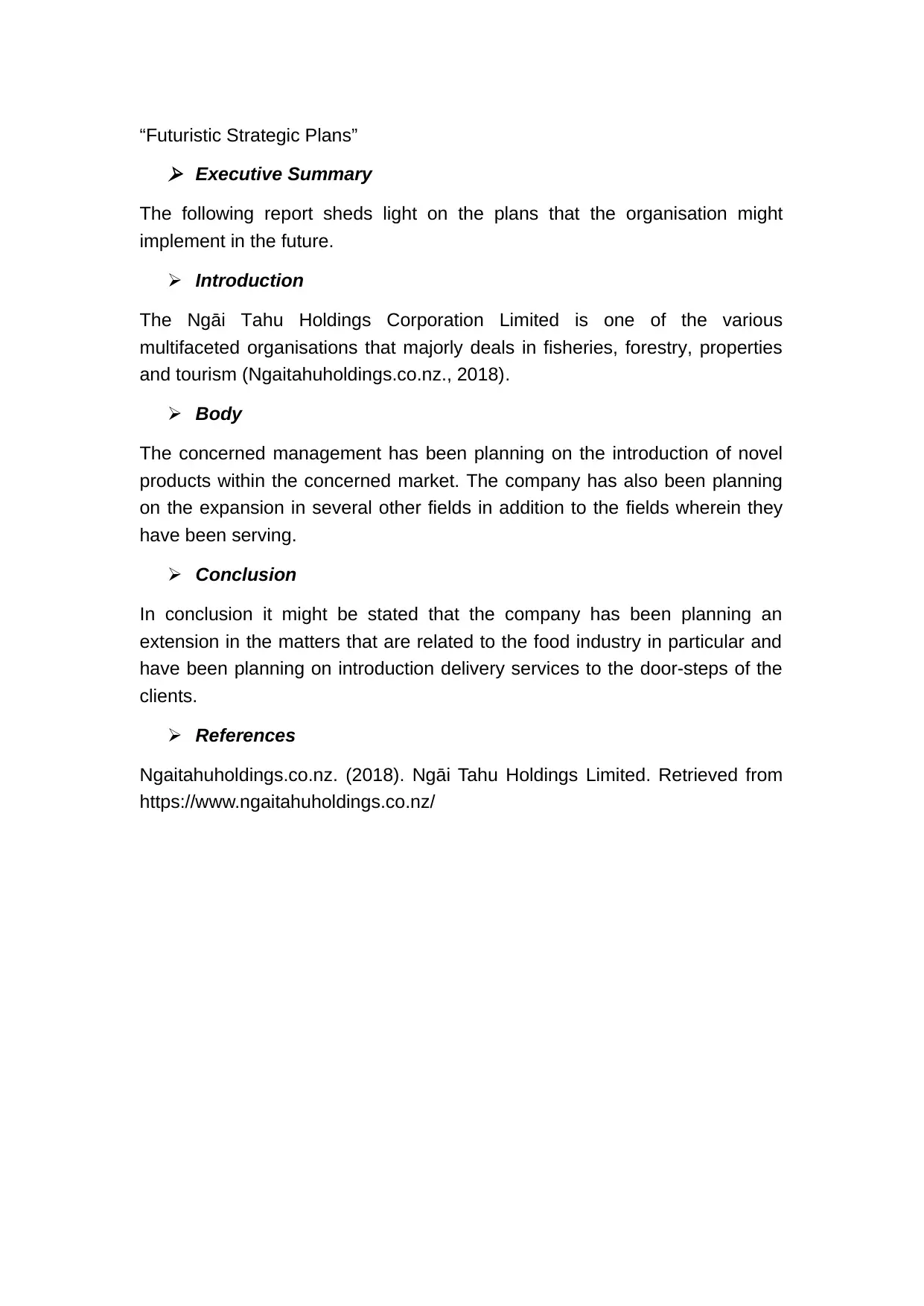
“Futuristic Strategic Plans” Executive Summary
The following report sheds light on the plans that the organisation might
implement in the future.
Introduction
The Ngāi Tahu Holdings Corporation Limited is one of the various
multifaceted organisations that majorly deals in fisheries, forestry, properties
and tourism (Ngaitahuholdings.co.nz., 2018).
Body
The concerned management has been planning on the introduction of novel
products within the concerned market. The company has also been planning
on the expansion in several other fields in addition to the fields wherein they
have been serving.
Conclusion
In conclusion it might be stated that the company has been planning an
extension in the matters that are related to the food industry in particular and
have been planning on introduction delivery services to the door-steps of the
clients.
References
Ngaitahuholdings.co.nz. (2018). Ngāi Tahu Holdings Limited. Retrieved from
https://www.ngaitahuholdings.co.nz/
The following report sheds light on the plans that the organisation might
implement in the future.
Introduction
The Ngāi Tahu Holdings Corporation Limited is one of the various
multifaceted organisations that majorly deals in fisheries, forestry, properties
and tourism (Ngaitahuholdings.co.nz., 2018).
Body
The concerned management has been planning on the introduction of novel
products within the concerned market. The company has also been planning
on the expansion in several other fields in addition to the fields wherein they
have been serving.
Conclusion
In conclusion it might be stated that the company has been planning an
extension in the matters that are related to the food industry in particular and
have been planning on introduction delivery services to the door-steps of the
clients.
References
Ngaitahuholdings.co.nz. (2018). Ngāi Tahu Holdings Limited. Retrieved from
https://www.ngaitahuholdings.co.nz/
Paraphrase This Document
Need a fresh take? Get an instant paraphrase of this document with our AI Paraphraser
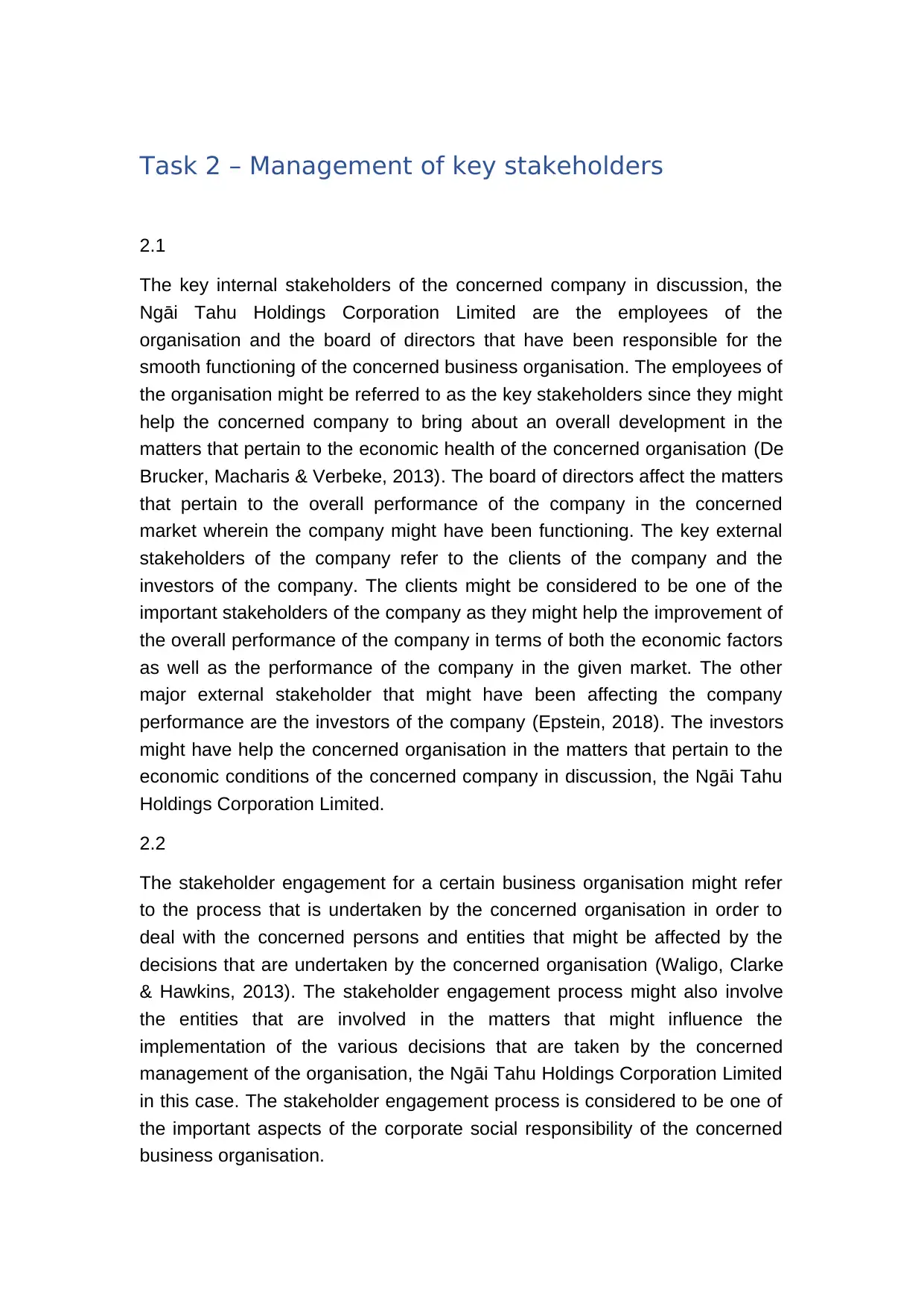
Task 2 – Management of key stakeholders
2.1
The key internal stakeholders of the concerned company in discussion, the
Ngāi Tahu Holdings Corporation Limited are the employees of the
organisation and the board of directors that have been responsible for the
smooth functioning of the concerned business organisation. The employees of
the organisation might be referred to as the key stakeholders since they might
help the concerned company to bring about an overall development in the
matters that pertain to the economic health of the concerned organisation (De
Brucker, Macharis & Verbeke, 2013). The board of directors affect the matters
that pertain to the overall performance of the company in the concerned
market wherein the company might have been functioning. The key external
stakeholders of the company refer to the clients of the company and the
investors of the company. The clients might be considered to be one of the
important stakeholders of the company as they might help the improvement of
the overall performance of the company in terms of both the economic factors
as well as the performance of the company in the given market. The other
major external stakeholder that might have been affecting the company
performance are the investors of the company (Epstein, 2018). The investors
might have help the concerned organisation in the matters that pertain to the
economic conditions of the concerned company in discussion, the Ngāi Tahu
Holdings Corporation Limited.
2.2
The stakeholder engagement for a certain business organisation might refer
to the process that is undertaken by the concerned organisation in order to
deal with the concerned persons and entities that might be affected by the
decisions that are undertaken by the concerned organisation (Waligo, Clarke
& Hawkins, 2013). The stakeholder engagement process might also involve
the entities that are involved in the matters that might influence the
implementation of the various decisions that are taken by the concerned
management of the organisation, the Ngāi Tahu Holdings Corporation Limited
in this case. The stakeholder engagement process is considered to be one of
the important aspects of the corporate social responsibility of the concerned
business organisation.
2.1
The key internal stakeholders of the concerned company in discussion, the
Ngāi Tahu Holdings Corporation Limited are the employees of the
organisation and the board of directors that have been responsible for the
smooth functioning of the concerned business organisation. The employees of
the organisation might be referred to as the key stakeholders since they might
help the concerned company to bring about an overall development in the
matters that pertain to the economic health of the concerned organisation (De
Brucker, Macharis & Verbeke, 2013). The board of directors affect the matters
that pertain to the overall performance of the company in the concerned
market wherein the company might have been functioning. The key external
stakeholders of the company refer to the clients of the company and the
investors of the company. The clients might be considered to be one of the
important stakeholders of the company as they might help the improvement of
the overall performance of the company in terms of both the economic factors
as well as the performance of the company in the given market. The other
major external stakeholder that might have been affecting the company
performance are the investors of the company (Epstein, 2018). The investors
might have help the concerned organisation in the matters that pertain to the
economic conditions of the concerned company in discussion, the Ngāi Tahu
Holdings Corporation Limited.
2.2
The stakeholder engagement for a certain business organisation might refer
to the process that is undertaken by the concerned organisation in order to
deal with the concerned persons and entities that might be affected by the
decisions that are undertaken by the concerned organisation (Waligo, Clarke
& Hawkins, 2013). The stakeholder engagement process might also involve
the entities that are involved in the matters that might influence the
implementation of the various decisions that are taken by the concerned
management of the organisation, the Ngāi Tahu Holdings Corporation Limited
in this case. The stakeholder engagement process is considered to be one of
the important aspects of the corporate social responsibility of the concerned
business organisation.
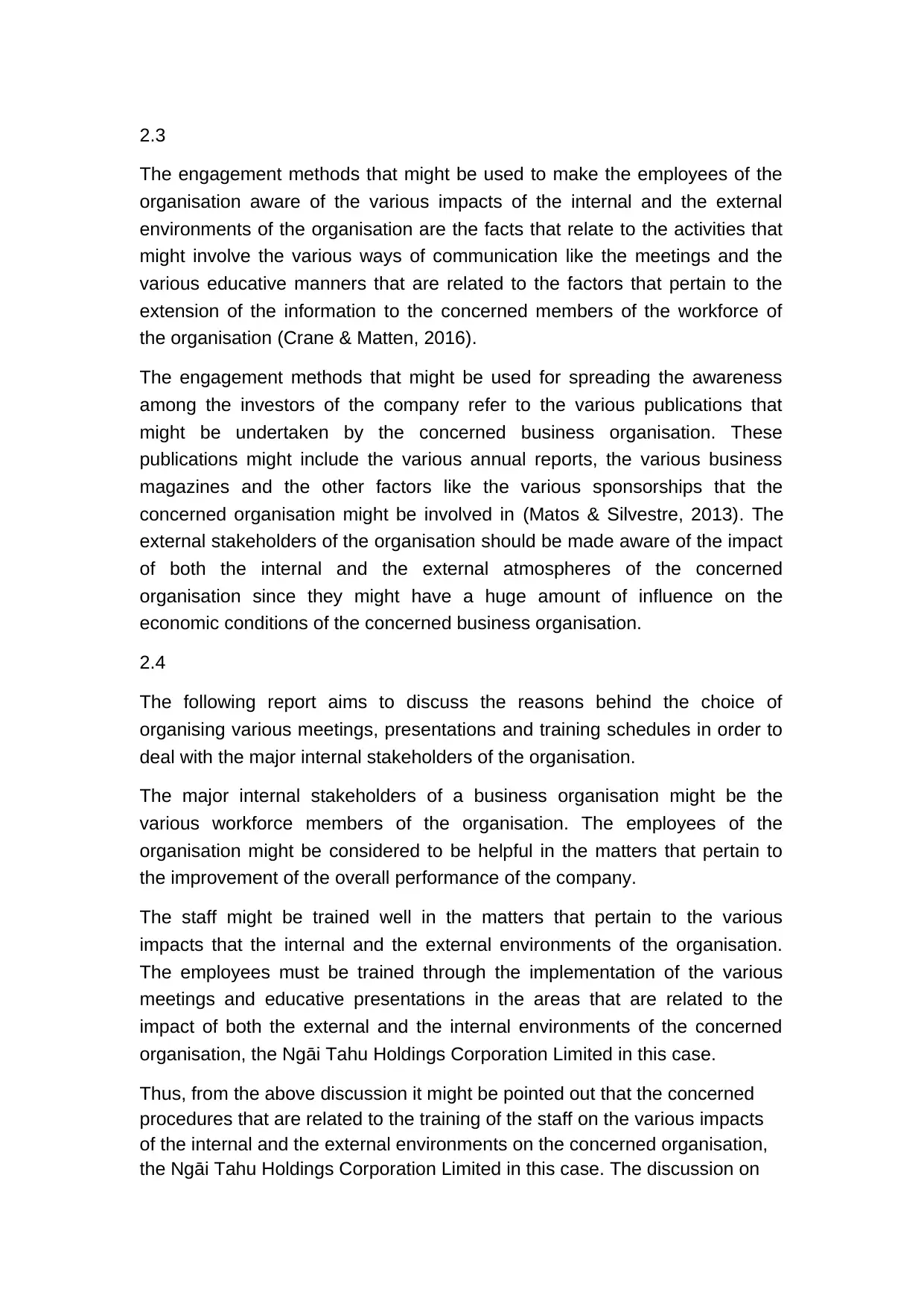
2.3
The engagement methods that might be used to make the employees of the
organisation aware of the various impacts of the internal and the external
environments of the organisation are the facts that relate to the activities that
might involve the various ways of communication like the meetings and the
various educative manners that are related to the factors that pertain to the
extension of the information to the concerned members of the workforce of
the organisation (Crane & Matten, 2016).
The engagement methods that might be used for spreading the awareness
among the investors of the company refer to the various publications that
might be undertaken by the concerned business organisation. These
publications might include the various annual reports, the various business
magazines and the other factors like the various sponsorships that the
concerned organisation might be involved in (Matos & Silvestre, 2013). The
external stakeholders of the organisation should be made aware of the impact
of both the internal and the external atmospheres of the concerned
organisation since they might have a huge amount of influence on the
economic conditions of the concerned business organisation.
2.4
The following report aims to discuss the reasons behind the choice of
organising various meetings, presentations and training schedules in order to
deal with the major internal stakeholders of the organisation.
The major internal stakeholders of a business organisation might be the
various workforce members of the organisation. The employees of the
organisation might be considered to be helpful in the matters that pertain to
the improvement of the overall performance of the company.
The staff might be trained well in the matters that pertain to the various
impacts that the internal and the external environments of the organisation.
The employees must be trained through the implementation of the various
meetings and educative presentations in the areas that are related to the
impact of both the external and the internal environments of the concerned
organisation, the Ngāi Tahu Holdings Corporation Limited in this case.
Thus, from the above discussion it might be pointed out that the concerned
procedures that are related to the training of the staff on the various impacts
of the internal and the external environments on the concerned organisation,
the Ngāi Tahu Holdings Corporation Limited in this case. The discussion on
The engagement methods that might be used to make the employees of the
organisation aware of the various impacts of the internal and the external
environments of the organisation are the facts that relate to the activities that
might involve the various ways of communication like the meetings and the
various educative manners that are related to the factors that pertain to the
extension of the information to the concerned members of the workforce of
the organisation (Crane & Matten, 2016).
The engagement methods that might be used for spreading the awareness
among the investors of the company refer to the various publications that
might be undertaken by the concerned business organisation. These
publications might include the various annual reports, the various business
magazines and the other factors like the various sponsorships that the
concerned organisation might be involved in (Matos & Silvestre, 2013). The
external stakeholders of the organisation should be made aware of the impact
of both the internal and the external atmospheres of the concerned
organisation since they might have a huge amount of influence on the
economic conditions of the concerned business organisation.
2.4
The following report aims to discuss the reasons behind the choice of
organising various meetings, presentations and training schedules in order to
deal with the major internal stakeholders of the organisation.
The major internal stakeholders of a business organisation might be the
various workforce members of the organisation. The employees of the
organisation might be considered to be helpful in the matters that pertain to
the improvement of the overall performance of the company.
The staff might be trained well in the matters that pertain to the various
impacts that the internal and the external environments of the organisation.
The employees must be trained through the implementation of the various
meetings and educative presentations in the areas that are related to the
impact of both the external and the internal environments of the concerned
organisation, the Ngāi Tahu Holdings Corporation Limited in this case.
Thus, from the above discussion it might be pointed out that the concerned
procedures that are related to the training of the staff on the various impacts
of the internal and the external environments on the concerned organisation,
the Ngāi Tahu Holdings Corporation Limited in this case. The discussion on
You're viewing a preview
Unlock full access by subscribing today!
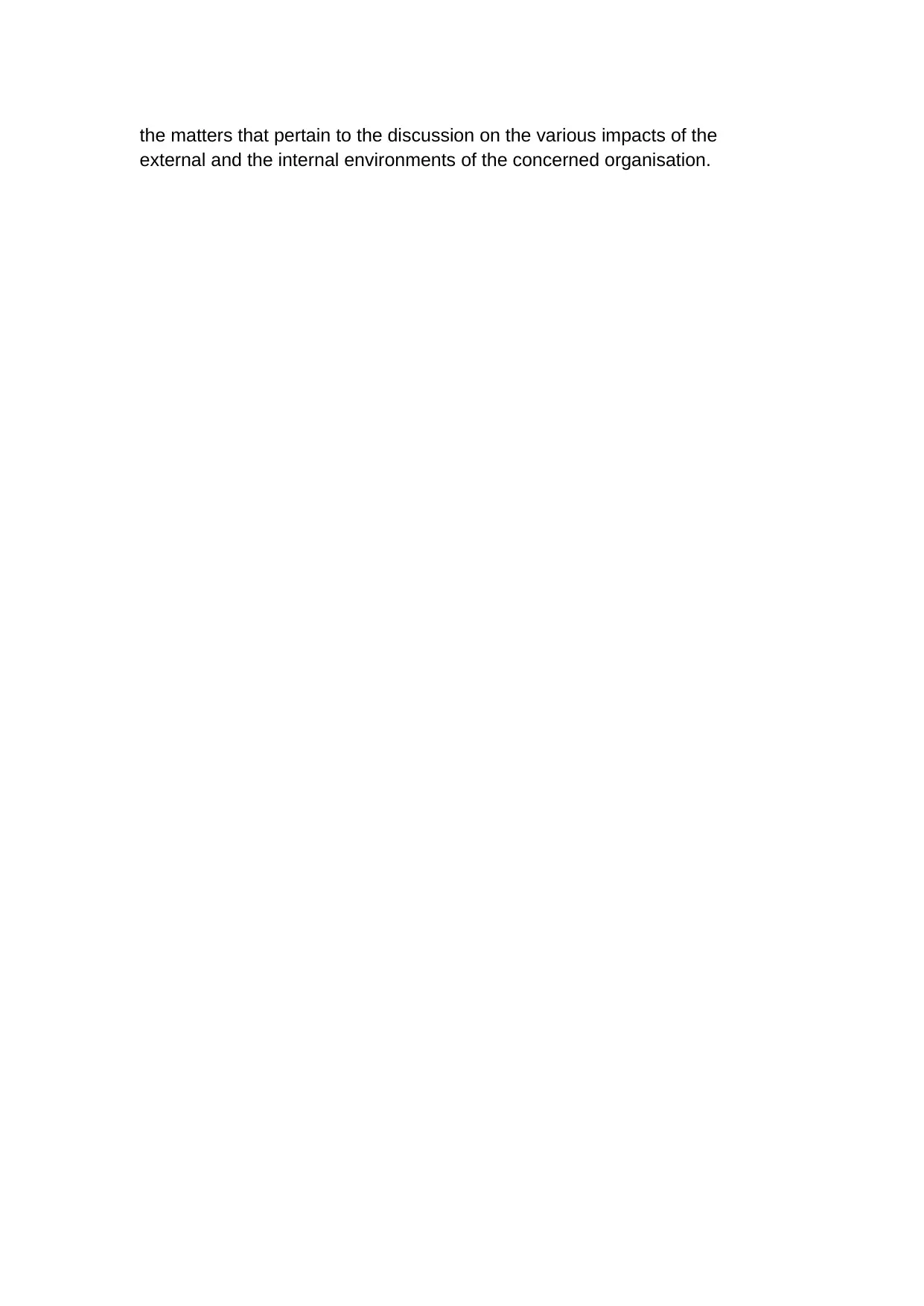
the matters that pertain to the discussion on the various impacts of the
external and the internal environments of the concerned organisation.
external and the internal environments of the concerned organisation.
Paraphrase This Document
Need a fresh take? Get an instant paraphrase of this document with our AI Paraphraser
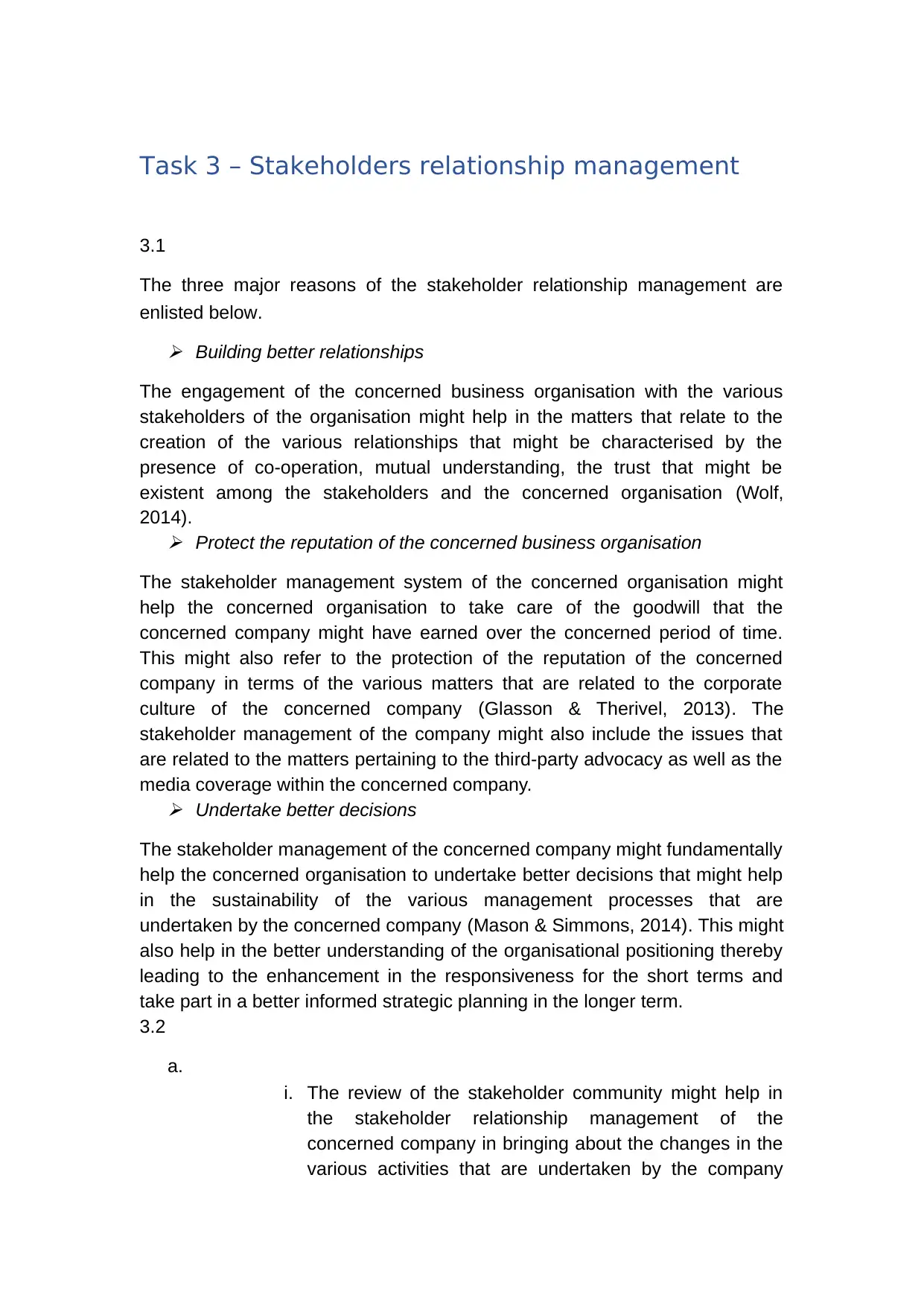
Task 3 – Stakeholders relationship management
3.1
The three major reasons of the stakeholder relationship management are
enlisted below. Building better relationships
The engagement of the concerned business organisation with the various
stakeholders of the organisation might help in the matters that relate to the
creation of the various relationships that might be characterised by the
presence of co-operation, mutual understanding, the trust that might be
existent among the stakeholders and the concerned organisation (Wolf,
2014).
Protect the reputation of the concerned business organisation
The stakeholder management system of the concerned organisation might
help the concerned organisation to take care of the goodwill that the
concerned company might have earned over the concerned period of time.
This might also refer to the protection of the reputation of the concerned
company in terms of the various matters that are related to the corporate
culture of the concerned company (Glasson & Therivel, 2013). The
stakeholder management of the company might also include the issues that
are related to the matters pertaining to the third-party advocacy as well as the
media coverage within the concerned company.
Undertake better decisions
The stakeholder management of the concerned company might fundamentally
help the concerned organisation to undertake better decisions that might help
in the sustainability of the various management processes that are
undertaken by the concerned company (Mason & Simmons, 2014). This might
also help in the better understanding of the organisational positioning thereby
leading to the enhancement in the responsiveness for the short terms and
take part in a better informed strategic planning in the longer term.
3.2
a.
i. The review of the stakeholder community might help in
the stakeholder relationship management of the
concerned company in bringing about the changes in the
various activities that are undertaken by the company
3.1
The three major reasons of the stakeholder relationship management are
enlisted below. Building better relationships
The engagement of the concerned business organisation with the various
stakeholders of the organisation might help in the matters that relate to the
creation of the various relationships that might be characterised by the
presence of co-operation, mutual understanding, the trust that might be
existent among the stakeholders and the concerned organisation (Wolf,
2014).
Protect the reputation of the concerned business organisation
The stakeholder management system of the concerned organisation might
help the concerned organisation to take care of the goodwill that the
concerned company might have earned over the concerned period of time.
This might also refer to the protection of the reputation of the concerned
company in terms of the various matters that are related to the corporate
culture of the concerned company (Glasson & Therivel, 2013). The
stakeholder management of the company might also include the issues that
are related to the matters pertaining to the third-party advocacy as well as the
media coverage within the concerned company.
Undertake better decisions
The stakeholder management of the concerned company might fundamentally
help the concerned organisation to undertake better decisions that might help
in the sustainability of the various management processes that are
undertaken by the concerned company (Mason & Simmons, 2014). This might
also help in the better understanding of the organisational positioning thereby
leading to the enhancement in the responsiveness for the short terms and
take part in a better informed strategic planning in the longer term.
3.2
a.
i. The review of the stakeholder community might help in
the stakeholder relationship management of the
concerned company in bringing about the changes in the
various activities that are undertaken by the company
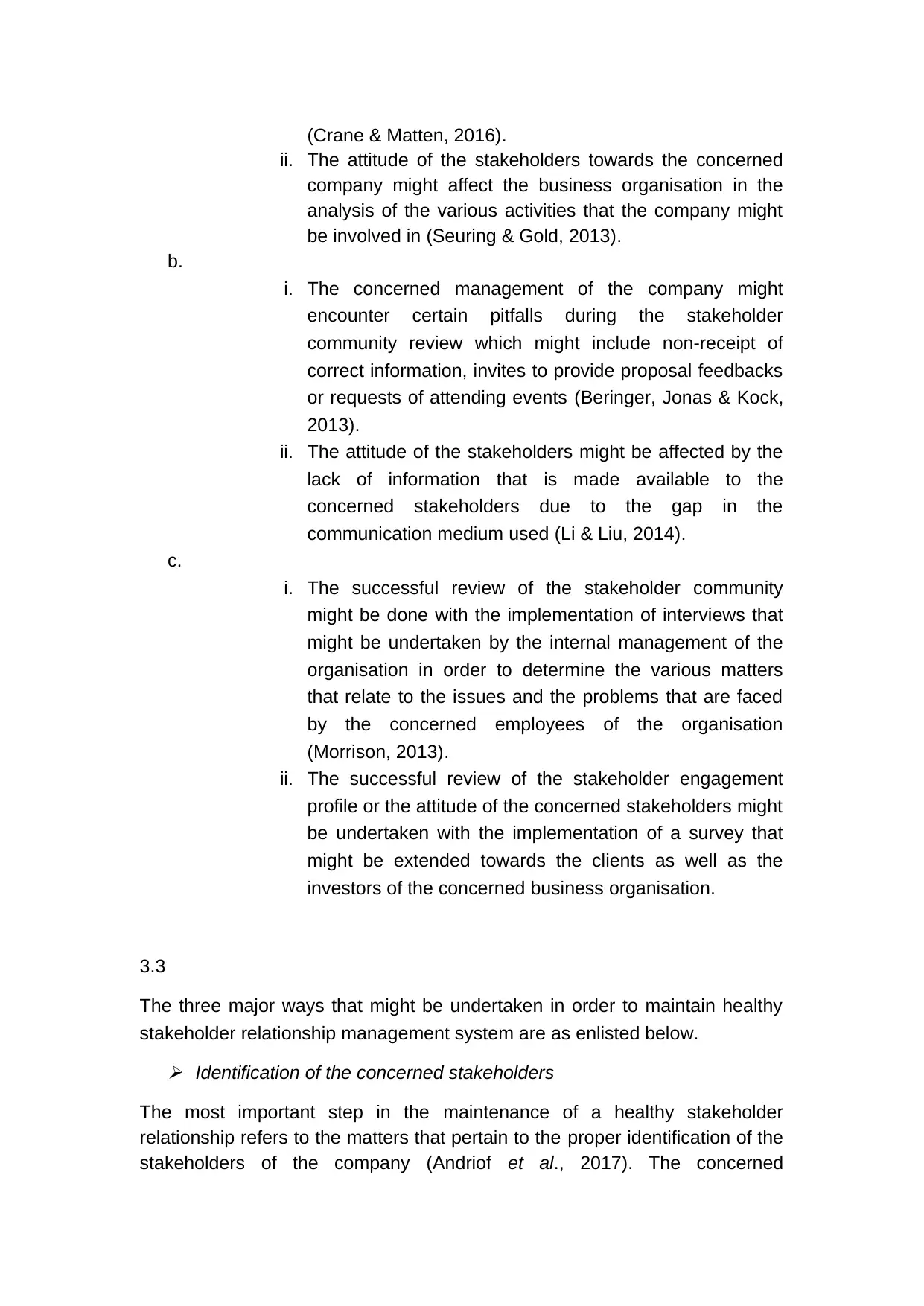
(Crane & Matten, 2016).
ii. The attitude of the stakeholders towards the concerned
company might affect the business organisation in the
analysis of the various activities that the company might
be involved in (Seuring & Gold, 2013).
b.
i. The concerned management of the company might
encounter certain pitfalls during the stakeholder
community review which might include non-receipt of
correct information, invites to provide proposal feedbacks
or requests of attending events (Beringer, Jonas & Kock,
2013).
ii. The attitude of the stakeholders might be affected by the
lack of information that is made available to the
concerned stakeholders due to the gap in the
communication medium used (Li & Liu, 2014).
c.
i. The successful review of the stakeholder community
might be done with the implementation of interviews that
might be undertaken by the internal management of the
organisation in order to determine the various matters
that relate to the issues and the problems that are faced
by the concerned employees of the organisation
(Morrison, 2013).
ii. The successful review of the stakeholder engagement
profile or the attitude of the concerned stakeholders might
be undertaken with the implementation of a survey that
might be extended towards the clients as well as the
investors of the concerned business organisation.
3.3
The three major ways that might be undertaken in order to maintain healthy
stakeholder relationship management system are as enlisted below. Identification of the concerned stakeholders
The most important step in the maintenance of a healthy stakeholder
relationship refers to the matters that pertain to the proper identification of the
stakeholders of the company (Andriof et al., 2017). The concerned
ii. The attitude of the stakeholders towards the concerned
company might affect the business organisation in the
analysis of the various activities that the company might
be involved in (Seuring & Gold, 2013).
b.
i. The concerned management of the company might
encounter certain pitfalls during the stakeholder
community review which might include non-receipt of
correct information, invites to provide proposal feedbacks
or requests of attending events (Beringer, Jonas & Kock,
2013).
ii. The attitude of the stakeholders might be affected by the
lack of information that is made available to the
concerned stakeholders due to the gap in the
communication medium used (Li & Liu, 2014).
c.
i. The successful review of the stakeholder community
might be done with the implementation of interviews that
might be undertaken by the internal management of the
organisation in order to determine the various matters
that relate to the issues and the problems that are faced
by the concerned employees of the organisation
(Morrison, 2013).
ii. The successful review of the stakeholder engagement
profile or the attitude of the concerned stakeholders might
be undertaken with the implementation of a survey that
might be extended towards the clients as well as the
investors of the concerned business organisation.
3.3
The three major ways that might be undertaken in order to maintain healthy
stakeholder relationship management system are as enlisted below. Identification of the concerned stakeholders
The most important step in the maintenance of a healthy stakeholder
relationship refers to the matters that pertain to the proper identification of the
stakeholders of the company (Andriof et al., 2017). The concerned
You're viewing a preview
Unlock full access by subscribing today!
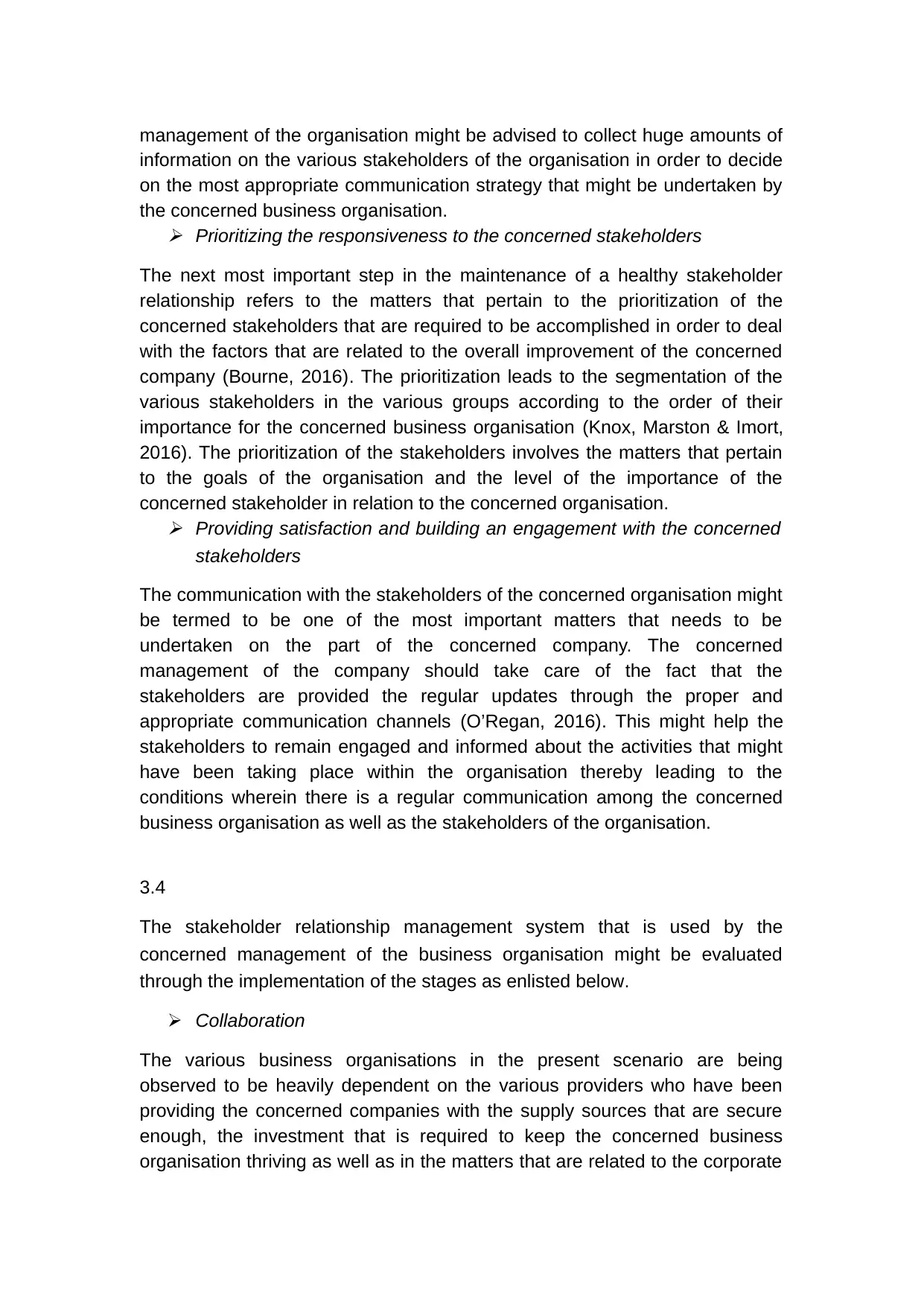
management of the organisation might be advised to collect huge amounts of
information on the various stakeholders of the organisation in order to decide
on the most appropriate communication strategy that might be undertaken by
the concerned business organisation.
Prioritizing the responsiveness to the concerned stakeholders
The next most important step in the maintenance of a healthy stakeholder
relationship refers to the matters that pertain to the prioritization of the
concerned stakeholders that are required to be accomplished in order to deal
with the factors that are related to the overall improvement of the concerned
company (Bourne, 2016). The prioritization leads to the segmentation of the
various stakeholders in the various groups according to the order of their
importance for the concerned business organisation (Knox, Marston & Imort,
2016). The prioritization of the stakeholders involves the matters that pertain
to the goals of the organisation and the level of the importance of the
concerned stakeholder in relation to the concerned organisation.
Providing satisfaction and building an engagement with the concerned
stakeholders
The communication with the stakeholders of the concerned organisation might
be termed to be one of the most important matters that needs to be
undertaken on the part of the concerned company. The concerned
management of the company should take care of the fact that the
stakeholders are provided the regular updates through the proper and
appropriate communication channels (O’Regan, 2016). This might help the
stakeholders to remain engaged and informed about the activities that might
have been taking place within the organisation thereby leading to the
conditions wherein there is a regular communication among the concerned
business organisation as well as the stakeholders of the organisation.
3.4
The stakeholder relationship management system that is used by the
concerned management of the business organisation might be evaluated
through the implementation of the stages as enlisted below.
Collaboration
The various business organisations in the present scenario are being
observed to be heavily dependent on the various providers who have been
providing the concerned companies with the supply sources that are secure
enough, the investment that is required to keep the concerned business
organisation thriving as well as in the matters that are related to the corporate
information on the various stakeholders of the organisation in order to decide
on the most appropriate communication strategy that might be undertaken by
the concerned business organisation.
Prioritizing the responsiveness to the concerned stakeholders
The next most important step in the maintenance of a healthy stakeholder
relationship refers to the matters that pertain to the prioritization of the
concerned stakeholders that are required to be accomplished in order to deal
with the factors that are related to the overall improvement of the concerned
company (Bourne, 2016). The prioritization leads to the segmentation of the
various stakeholders in the various groups according to the order of their
importance for the concerned business organisation (Knox, Marston & Imort,
2016). The prioritization of the stakeholders involves the matters that pertain
to the goals of the organisation and the level of the importance of the
concerned stakeholder in relation to the concerned organisation.
Providing satisfaction and building an engagement with the concerned
stakeholders
The communication with the stakeholders of the concerned organisation might
be termed to be one of the most important matters that needs to be
undertaken on the part of the concerned company. The concerned
management of the company should take care of the fact that the
stakeholders are provided the regular updates through the proper and
appropriate communication channels (O’Regan, 2016). This might help the
stakeholders to remain engaged and informed about the activities that might
have been taking place within the organisation thereby leading to the
conditions wherein there is a regular communication among the concerned
business organisation as well as the stakeholders of the organisation.
3.4
The stakeholder relationship management system that is used by the
concerned management of the business organisation might be evaluated
through the implementation of the stages as enlisted below.
Collaboration
The various business organisations in the present scenario are being
observed to be heavily dependent on the various providers who have been
providing the concerned companies with the supply sources that are secure
enough, the investment that is required to keep the concerned business
organisation thriving as well as in the matters that are related to the corporate
Paraphrase This Document
Need a fresh take? Get an instant paraphrase of this document with our AI Paraphraser
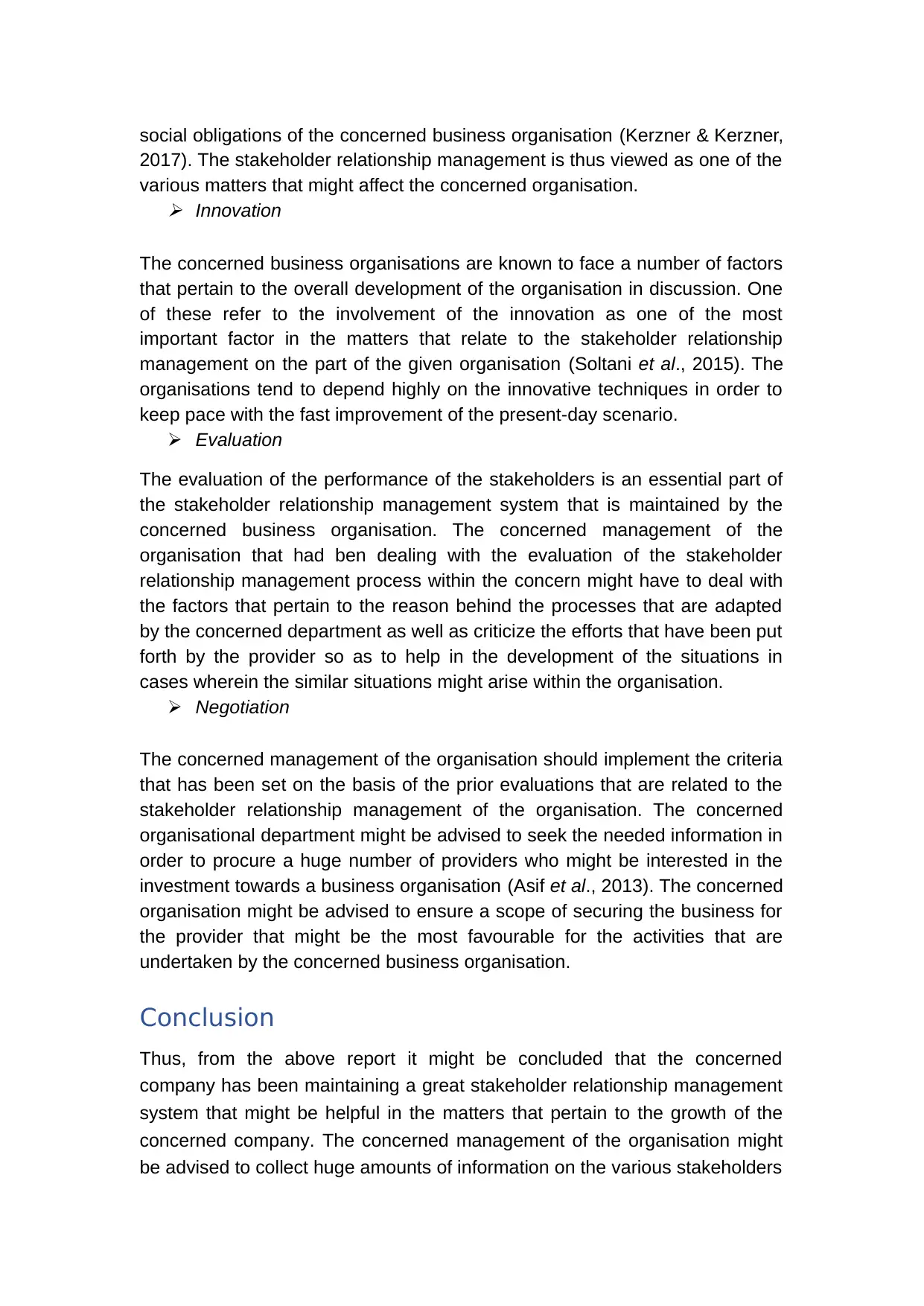
social obligations of the concerned business organisation (Kerzner & Kerzner,
2017). The stakeholder relationship management is thus viewed as one of the
various matters that might affect the concerned organisation.
Innovation
The concerned business organisations are known to face a number of factors
that pertain to the overall development of the organisation in discussion. One
of these refer to the involvement of the innovation as one of the most
important factor in the matters that relate to the stakeholder relationship
management on the part of the given organisation (Soltani et al., 2015). The
organisations tend to depend highly on the innovative techniques in order to
keep pace with the fast improvement of the present-day scenario.
Evaluation
The evaluation of the performance of the stakeholders is an essential part of
the stakeholder relationship management system that is maintained by the
concerned business organisation. The concerned management of the
organisation that had ben dealing with the evaluation of the stakeholder
relationship management process within the concern might have to deal with
the factors that pertain to the reason behind the processes that are adapted
by the concerned department as well as criticize the efforts that have been put
forth by the provider so as to help in the development of the situations in
cases wherein the similar situations might arise within the organisation.
Negotiation
The concerned management of the organisation should implement the criteria
that has been set on the basis of the prior evaluations that are related to the
stakeholder relationship management of the organisation. The concerned
organisational department might be advised to seek the needed information in
order to procure a huge number of providers who might be interested in the
investment towards a business organisation (Asif et al., 2013). The concerned
organisation might be advised to ensure a scope of securing the business for
the provider that might be the most favourable for the activities that are
undertaken by the concerned business organisation.
Conclusion
Thus, from the above report it might be concluded that the concerned
company has been maintaining a great stakeholder relationship management
system that might be helpful in the matters that pertain to the growth of the
concerned company. The concerned management of the organisation might
be advised to collect huge amounts of information on the various stakeholders
2017). The stakeholder relationship management is thus viewed as one of the
various matters that might affect the concerned organisation.
Innovation
The concerned business organisations are known to face a number of factors
that pertain to the overall development of the organisation in discussion. One
of these refer to the involvement of the innovation as one of the most
important factor in the matters that relate to the stakeholder relationship
management on the part of the given organisation (Soltani et al., 2015). The
organisations tend to depend highly on the innovative techniques in order to
keep pace with the fast improvement of the present-day scenario.
Evaluation
The evaluation of the performance of the stakeholders is an essential part of
the stakeholder relationship management system that is maintained by the
concerned business organisation. The concerned management of the
organisation that had ben dealing with the evaluation of the stakeholder
relationship management process within the concern might have to deal with
the factors that pertain to the reason behind the processes that are adapted
by the concerned department as well as criticize the efforts that have been put
forth by the provider so as to help in the development of the situations in
cases wherein the similar situations might arise within the organisation.
Negotiation
The concerned management of the organisation should implement the criteria
that has been set on the basis of the prior evaluations that are related to the
stakeholder relationship management of the organisation. The concerned
organisational department might be advised to seek the needed information in
order to procure a huge number of providers who might be interested in the
investment towards a business organisation (Asif et al., 2013). The concerned
organisation might be advised to ensure a scope of securing the business for
the provider that might be the most favourable for the activities that are
undertaken by the concerned business organisation.
Conclusion
Thus, from the above report it might be concluded that the concerned
company has been maintaining a great stakeholder relationship management
system that might be helpful in the matters that pertain to the growth of the
concerned company. The concerned management of the organisation might
be advised to collect huge amounts of information on the various stakeholders
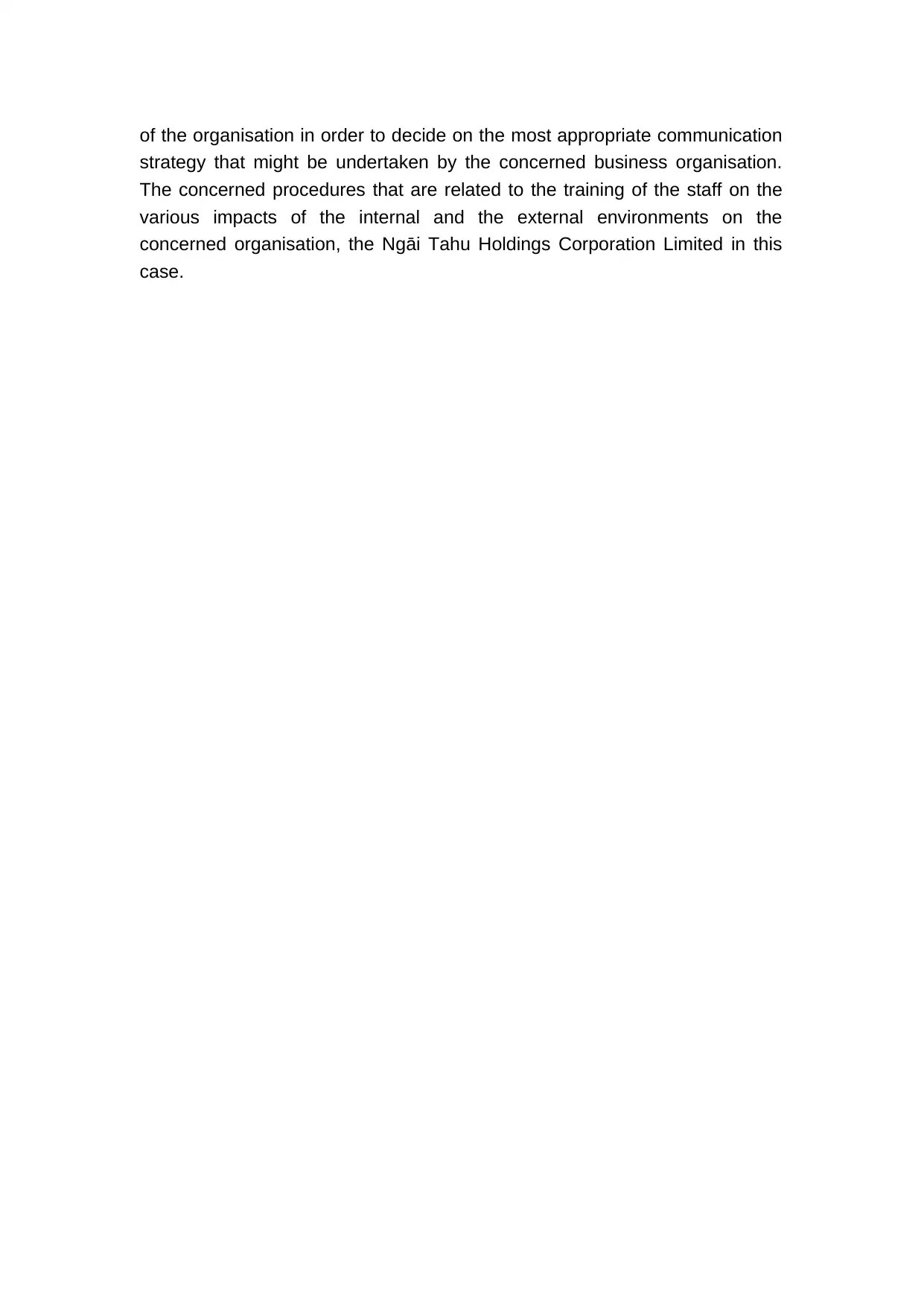
of the organisation in order to decide on the most appropriate communication
strategy that might be undertaken by the concerned business organisation.
The concerned procedures that are related to the training of the staff on the
various impacts of the internal and the external environments on the
concerned organisation, the Ngāi Tahu Holdings Corporation Limited in this
case.
strategy that might be undertaken by the concerned business organisation.
The concerned procedures that are related to the training of the staff on the
various impacts of the internal and the external environments on the
concerned organisation, the Ngāi Tahu Holdings Corporation Limited in this
case.
You're viewing a preview
Unlock full access by subscribing today!
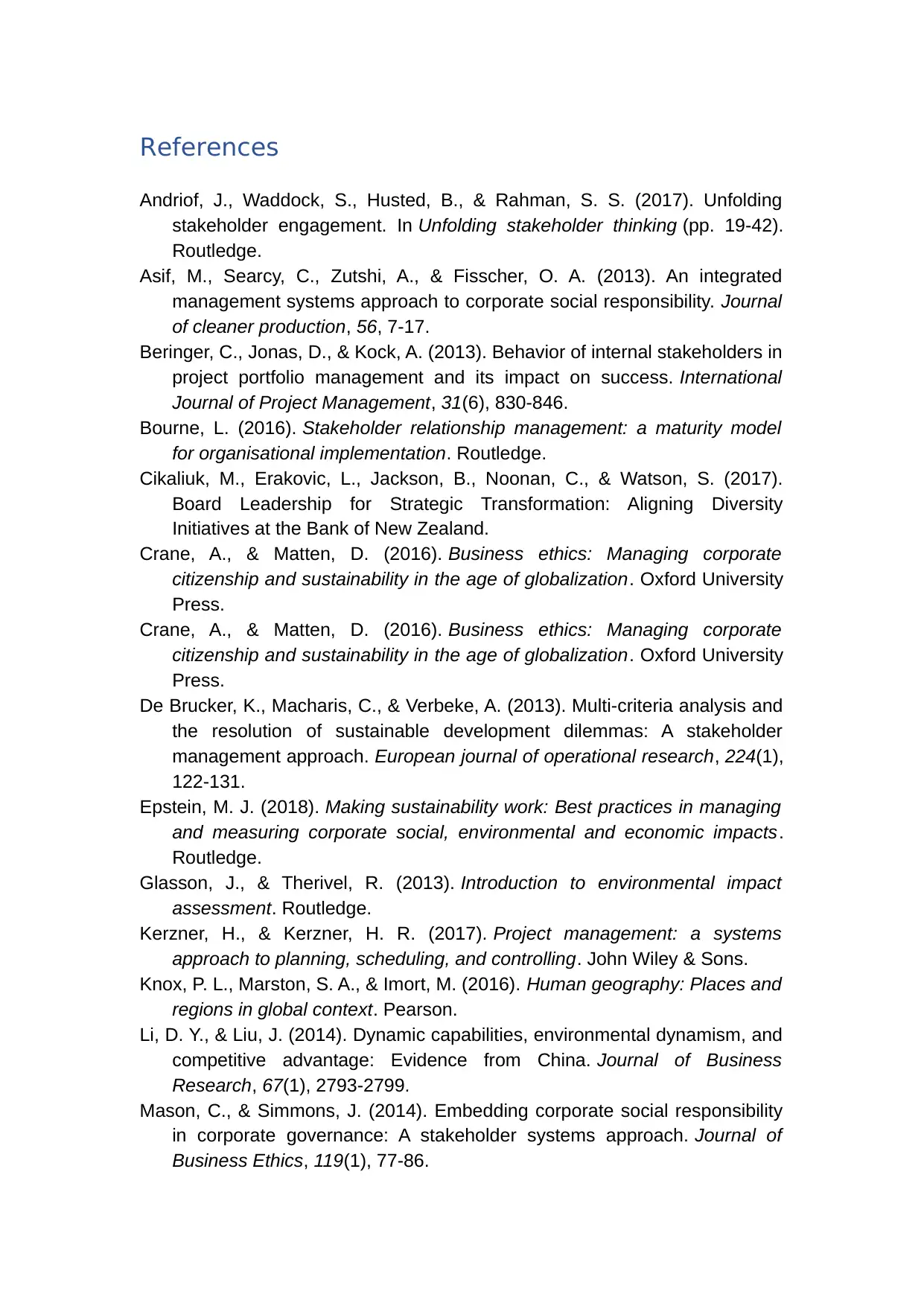
References
Andriof, J., Waddock, S., Husted, B., & Rahman, S. S. (2017). Unfolding
stakeholder engagement. In Unfolding stakeholder thinking (pp. 19-42).
Routledge.
Asif, M., Searcy, C., Zutshi, A., & Fisscher, O. A. (2013). An integrated
management systems approach to corporate social responsibility. Journal
of cleaner production, 56, 7-17.
Beringer, C., Jonas, D., & Kock, A. (2013). Behavior of internal stakeholders in
project portfolio management and its impact on success. International
Journal of Project Management, 31(6), 830-846.
Bourne, L. (2016). Stakeholder relationship management: a maturity model
for organisational implementation. Routledge.
Cikaliuk, M., Erakovic, L., Jackson, B., Noonan, C., & Watson, S. (2017).
Board Leadership for Strategic Transformation: Aligning Diversity
Initiatives at the Bank of New Zealand.
Crane, A., & Matten, D. (2016). Business ethics: Managing corporate
citizenship and sustainability in the age of globalization. Oxford University
Press.
Crane, A., & Matten, D. (2016). Business ethics: Managing corporate
citizenship and sustainability in the age of globalization. Oxford University
Press.
De Brucker, K., Macharis, C., & Verbeke, A. (2013). Multi-criteria analysis and
the resolution of sustainable development dilemmas: A stakeholder
management approach. European journal of operational research, 224(1),
122-131.
Epstein, M. J. (2018). Making sustainability work: Best practices in managing
and measuring corporate social, environmental and economic impacts.
Routledge.
Glasson, J., & Therivel, R. (2013). Introduction to environmental impact
assessment. Routledge.
Kerzner, H., & Kerzner, H. R. (2017). Project management: a systems
approach to planning, scheduling, and controlling. John Wiley & Sons.
Knox, P. L., Marston, S. A., & Imort, M. (2016). Human geography: Places and
regions in global context. Pearson.
Li, D. Y., & Liu, J. (2014). Dynamic capabilities, environmental dynamism, and
competitive advantage: Evidence from China. Journal of Business
Research, 67(1), 2793-2799.
Mason, C., & Simmons, J. (2014). Embedding corporate social responsibility
in corporate governance: A stakeholder systems approach. Journal of
Business Ethics, 119(1), 77-86.
Andriof, J., Waddock, S., Husted, B., & Rahman, S. S. (2017). Unfolding
stakeholder engagement. In Unfolding stakeholder thinking (pp. 19-42).
Routledge.
Asif, M., Searcy, C., Zutshi, A., & Fisscher, O. A. (2013). An integrated
management systems approach to corporate social responsibility. Journal
of cleaner production, 56, 7-17.
Beringer, C., Jonas, D., & Kock, A. (2013). Behavior of internal stakeholders in
project portfolio management and its impact on success. International
Journal of Project Management, 31(6), 830-846.
Bourne, L. (2016). Stakeholder relationship management: a maturity model
for organisational implementation. Routledge.
Cikaliuk, M., Erakovic, L., Jackson, B., Noonan, C., & Watson, S. (2017).
Board Leadership for Strategic Transformation: Aligning Diversity
Initiatives at the Bank of New Zealand.
Crane, A., & Matten, D. (2016). Business ethics: Managing corporate
citizenship and sustainability in the age of globalization. Oxford University
Press.
Crane, A., & Matten, D. (2016). Business ethics: Managing corporate
citizenship and sustainability in the age of globalization. Oxford University
Press.
De Brucker, K., Macharis, C., & Verbeke, A. (2013). Multi-criteria analysis and
the resolution of sustainable development dilemmas: A stakeholder
management approach. European journal of operational research, 224(1),
122-131.
Epstein, M. J. (2018). Making sustainability work: Best practices in managing
and measuring corporate social, environmental and economic impacts.
Routledge.
Glasson, J., & Therivel, R. (2013). Introduction to environmental impact
assessment. Routledge.
Kerzner, H., & Kerzner, H. R. (2017). Project management: a systems
approach to planning, scheduling, and controlling. John Wiley & Sons.
Knox, P. L., Marston, S. A., & Imort, M. (2016). Human geography: Places and
regions in global context. Pearson.
Li, D. Y., & Liu, J. (2014). Dynamic capabilities, environmental dynamism, and
competitive advantage: Evidence from China. Journal of Business
Research, 67(1), 2793-2799.
Mason, C., & Simmons, J. (2014). Embedding corporate social responsibility
in corporate governance: A stakeholder systems approach. Journal of
Business Ethics, 119(1), 77-86.
Paraphrase This Document
Need a fresh take? Get an instant paraphrase of this document with our AI Paraphraser
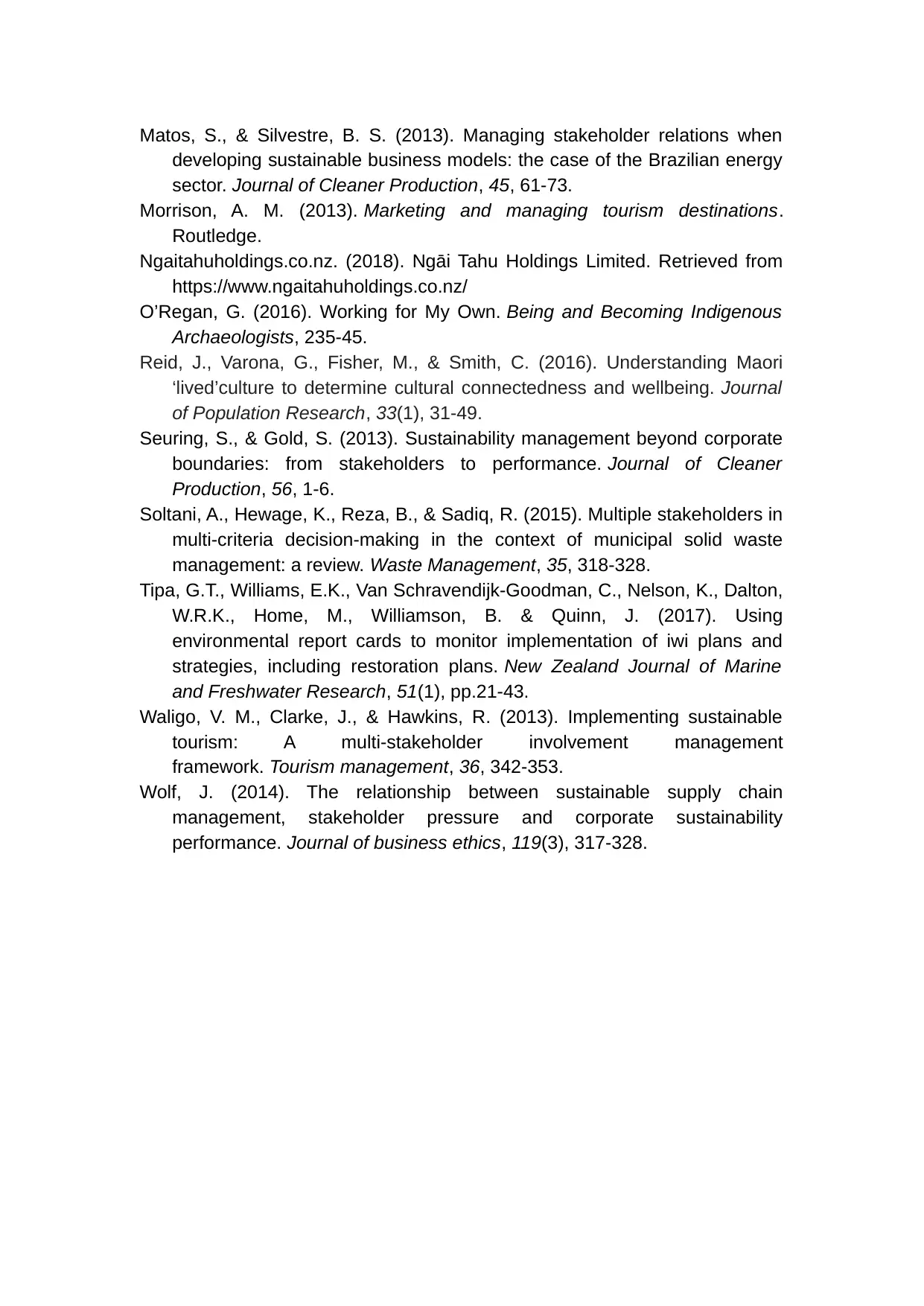
Matos, S., & Silvestre, B. S. (2013). Managing stakeholder relations when
developing sustainable business models: the case of the Brazilian energy
sector. Journal of Cleaner Production, 45, 61-73.
Morrison, A. M. (2013). Marketing and managing tourism destinations.
Routledge.
Ngaitahuholdings.co.nz. (2018). Ngāi Tahu Holdings Limited. Retrieved from
https://www.ngaitahuholdings.co.nz/
O’Regan, G. (2016). Working for My Own. Being and Becoming Indigenous
Archaeologists, 235-45.
Reid, J., Varona, G., Fisher, M., & Smith, C. (2016). Understanding Maori
‘lived’culture to determine cultural connectedness and wellbeing. Journal
of Population Research, 33(1), 31-49.
Seuring, S., & Gold, S. (2013). Sustainability management beyond corporate
boundaries: from stakeholders to performance. Journal of Cleaner
Production, 56, 1-6.
Soltani, A., Hewage, K., Reza, B., & Sadiq, R. (2015). Multiple stakeholders in
multi-criteria decision-making in the context of municipal solid waste
management: a review. Waste Management, 35, 318-328.
Tipa, G.T., Williams, E.K., Van Schravendijk-Goodman, C., Nelson, K., Dalton,
W.R.K., Home, M., Williamson, B. & Quinn, J. (2017). Using
environmental report cards to monitor implementation of iwi plans and
strategies, including restoration plans. New Zealand Journal of Marine
and Freshwater Research, 51(1), pp.21-43.
Waligo, V. M., Clarke, J., & Hawkins, R. (2013). Implementing sustainable
tourism: A multi-stakeholder involvement management
framework. Tourism management, 36, 342-353.
Wolf, J. (2014). The relationship between sustainable supply chain
management, stakeholder pressure and corporate sustainability
performance. Journal of business ethics, 119(3), 317-328.
developing sustainable business models: the case of the Brazilian energy
sector. Journal of Cleaner Production, 45, 61-73.
Morrison, A. M. (2013). Marketing and managing tourism destinations.
Routledge.
Ngaitahuholdings.co.nz. (2018). Ngāi Tahu Holdings Limited. Retrieved from
https://www.ngaitahuholdings.co.nz/
O’Regan, G. (2016). Working for My Own. Being and Becoming Indigenous
Archaeologists, 235-45.
Reid, J., Varona, G., Fisher, M., & Smith, C. (2016). Understanding Maori
‘lived’culture to determine cultural connectedness and wellbeing. Journal
of Population Research, 33(1), 31-49.
Seuring, S., & Gold, S. (2013). Sustainability management beyond corporate
boundaries: from stakeholders to performance. Journal of Cleaner
Production, 56, 1-6.
Soltani, A., Hewage, K., Reza, B., & Sadiq, R. (2015). Multiple stakeholders in
multi-criteria decision-making in the context of municipal solid waste
management: a review. Waste Management, 35, 318-328.
Tipa, G.T., Williams, E.K., Van Schravendijk-Goodman, C., Nelson, K., Dalton,
W.R.K., Home, M., Williamson, B. & Quinn, J. (2017). Using
environmental report cards to monitor implementation of iwi plans and
strategies, including restoration plans. New Zealand Journal of Marine
and Freshwater Research, 51(1), pp.21-43.
Waligo, V. M., Clarke, J., & Hawkins, R. (2013). Implementing sustainable
tourism: A multi-stakeholder involvement management
framework. Tourism management, 36, 342-353.
Wolf, J. (2014). The relationship between sustainable supply chain
management, stakeholder pressure and corporate sustainability
performance. Journal of business ethics, 119(3), 317-328.
1 out of 17
Related Documents
Your All-in-One AI-Powered Toolkit for Academic Success.
+13062052269
info@desklib.com
Available 24*7 on WhatsApp / Email
![[object Object]](/_next/static/media/star-bottom.7253800d.svg)
Unlock your academic potential
© 2024 | Zucol Services PVT LTD | All rights reserved.





